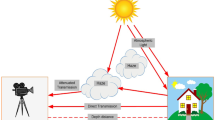Abstract
One of the key issues in image dehazing is how to accurately estimate the transmission map using strong priors or assumptions. By far the most common prior adopted by existing haze removal approaches is dark channel prior (DCP). Despite the remarkable progress, the existing DCP-based methods induce misestimation of the transmission while preventing halo artifacts, and may cause distortions of the recovered haze-free images in both chromaticity and contrast. This because they fail to observe the fact that the edges in a color image do not necessarily correspond to the changes in depth; instead, they try to preserve all types of edges indiscriminately in the estimated transmission map, which does not accord with the property of a realistic transmission map. In order to address this issue, we propose an efficient method for haze removal under the guidance of the depth edges. The main contribution of our study is that we present a depth edge prior to obtain the depth edges from the hazy image, and then employ a pixel-to-patch fusion scheme weighted by the depth edges to estimate the transmission directly, which can preserve the sharp discontinuity at depth edges but smooth the surface texture in the rest regions of the transmission map. The experimental results show that our approach can obtain more accurate estimation of the transmission, and consequently restore better quality haze-free images in terms of less color distortion and high contrast.









Similar content being viewed by others
References
Oakley JP, Satherley BL (1998) Improving image quality in poor visibility conditions using a physical model for contrast degradation. IEEE Trans Image Process 7(2):167–179
Narasimhan SG, Nayar SK (2003) Interactive (de) weathering of an image using physical models. In: IEEE Workshop on Color and Photometric Methods in Computer Vision, pp 1387–1394
Schechner YY, Narasimhan SG, Nayar SK (2003) Polarization-based vision through haze. Appl Opt 42(3):511–525
Shwartz S, Namer E, Schechner Y Y (2006) Blind Haze Separation. In: IEEE Computer Society Conference on Computer Vision and Pattern Recognition (CVPR), vol 2, pp 1984–1991
Narasimhan S G, Nayar S K (2000) Chromatic framework for vision in bad weather. In: IEEE Computer Society Conference on Computer Vision and Pattern Recognition (CVPR), vol 1, pp 598–605
Tan RT (2008) Visibility in bad weather from a single image. In: IEEE Computer Society Conference on Computer Vision and Pattern Recognition (CVPR), pp 1–8
Fattal R (2008) Single image dehazing. ACM Trans Graph 27(3):1–9
Kratz L, Nishino K (2009) Factorizing scene albedo and depth from a single foggy image. IEEE International Conference on Computer Vision, vol 30:1701–1708
He K, Sun J, Tang X (2011) Single image haze removal using dark channel prior. IEEE Transactions on Pattern Analysis & Machine Intelligence 33(12):2341–2353
Tarel JP, Hautiere N (2009) Fast visibility restoration from a single color or gray level image. IEEE International Conference on Computer Vision, vol 30:2201–2208
He K, Sun J, Tang X (2013) Guided image filtering. IEEE Transactions on Pattern Analysis & Machine Intelligence 35(6):1397–1409
Bui TM, Tran HN, Kim W et al (2014) Segmenting dark channel prior in single image dehazing. Electron Lett 50(7):516–518
Hsieh CH, Lin YS, Chang CH (2014) Haze removal without transmission map refinement based on dual dark channels. International Conference on Machine Learning and Cybernetics, vol 2:512–516
Shiau YH, Chen PY, Yang HY et al (2014) Weighted haze removal method with halo prevention. J Vis Commun Image Represent 25(2):445–453
Yu T, Riaz I, Piao J et al (2015) Real-time single image dehazing using block-to-pixel interpolation and adaptive dark channel prior. IET Image Process 9(9):725–734
Tang K, Yang J, Wang J (2014) Investigating haze-relevant features in a learning framework for image dehazing. In: IEEE Computer Society Conference on Computer Vision and Pattern Recognition (CVPR), pp 2995–3002
Li Z, Zheng J (2015) Edge-preserving decomposition based single image haze removal. IEEE Trans Image Process 24(12):1–1
Li Y, Miao Q, Song J et al (2016) Single image haze removal based on haze physical characteristics and adaptive sky region detection. Neurocomputing 182:221–234
McCartney EJ (1976) Optics of the atmosphere: scattering by molecules and particles. John Wiley and Sons, New York
Xiaowei Deng, Xiaolin Wu (2015) Sparsity-based depth image restoration using surface priors and rgb-d correlations. In: IEEE International Conference on Image Processing( ICIP), pp 3881–3885
Kim JH, Jang WD, Sim JY et al (2013) Optimized contrast enhancement for real-time image and video dehazing. J Vis Commun Image Represent 24(3):410–425
Jeong S, Lee S (2013) The single image dehazing based on efficient transmission estimation. In: IEEE International Conference on Consumer Electronics (ICCE). Las Vegas, pp 376–377
Wong E (2006) A New Method for Creating a Depth Map for Camera Auto Focus Using an All in Focus Picture and 2D Scale Space Matching. In: International Conference on Acoustics, vol 3, pp III-III
Huang YS, Cheng FH, Liang YH (2008) Creating depth map from 2D scene classification. International Conference on Innovative Computing Information and Control, vol 54:285–291
Acknowledgements
This work was jointly supported by the National Natural Science Foundation of China (No. 61301291); the 111 Project (B08038); Shaanxi province science and technology innovation team project (2013KCT-02). The authors would also like to thank Prof. Xiaolin Wu for his helpful comments regarding the improvement of this paper.
Author information
Authors and Affiliations
Corresponding author
Rights and permissions
About this article
Cite this article
Wang, K., Zhang, S. & Li, Y. Haze Removal via Edge Weighted Pixel-to-Patch Fusion. Mobile Netw Appl 22, 464–477 (2017). https://doi.org/10.1007/s11036-017-0869-y
Published:
Issue Date:
DOI: https://doi.org/10.1007/s11036-017-0869-y




